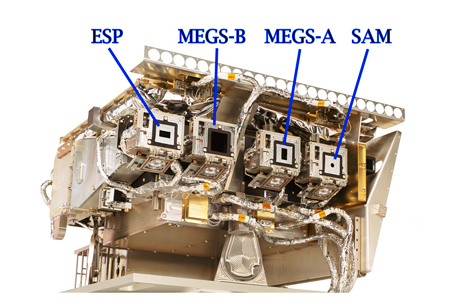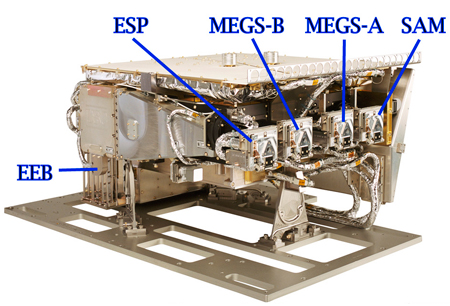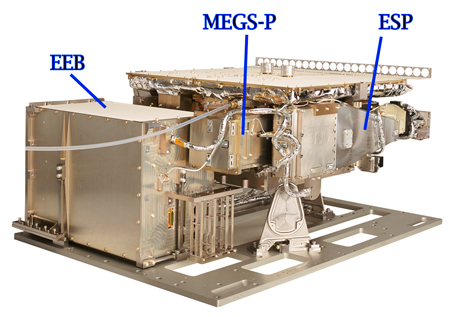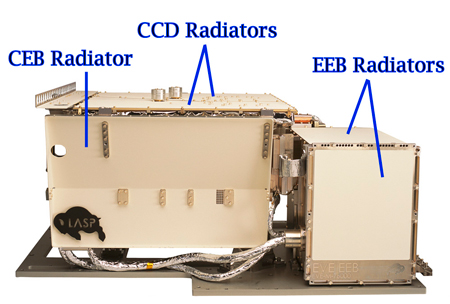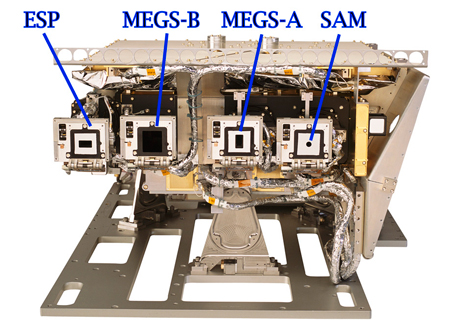EVE Overview
The Extreme ultraviolet Variabilty Experiment (EVE) is designed to measure the solar extreme ultraviolet (EUV) irradiance. The EUV radiation includes the 0.1-105 nm range, which provides the majority of the energy for heating Earth’s thermosphere and creating Earth’s ionosphere (ionized plasma). This wide spectral range requies the use of multiple channels. Some key requirements for EVE are to measure the solar EUV irradiance spectrum with 0.1 nm spectral resolution and with 20 sec cadence. These drive the EVE design to include grating spectrographs with array detectors so that all EUV wavelengths can be measured simultaneously. Another key requirement for EVE is to measure the EUV radiation with an accuracy of 25% or better, thus on-board calibration channels are included to go with underflight calibration experiments to be conducted during the SDO mission.
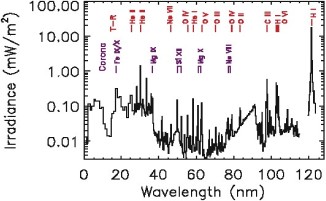
EVE Instrument Subsystems: MEGS, ESP, and EEB
- MEGS – Multiple Euv Grating Spectrograph: set of 2 Rowland-circle grating spectrographs that measure the 5-105 nm spectral irradiance with 0.1 nm spectral resolution and with 10-second cadence. Each spectrograph uses a back-illuminated 2048 x 1024 CCD camera from MIT Lincoln Laboratory. The CCD Electronics Box (CEB) is also part of MEGS. MEGS has 4 channels:
- MEGS-A: grazing incidence grating spectrograph for 5 nm to 37 nm range
- MEGS-B: double normal-incidence grating spectrograph for 35 nm to 105 nm
- MEGS-SAM: pinhole camera used with MEGS-A CCD to measure individual X-ray photons in the 0.1 nm to 7 nm range
- MEGS-P: photodiode used with the first grating in MEGS-B to measure the bright H I Lyman-alpha emission
- ESP – Euv SpectroPhotometer: transmission grating spectrograph that measures 4 bands in the 17-38 nm range and also 0.1-7 nm in zeroth order. ESP provides calibrations for MEGS sensitivity changes and higher time cadence (0.25-second). The ESP is very similar to the SOHO SEM instrument.
- EEB – EVE Electronics Box: electronics that control the MEGS and ESP instruments and provides an interface to/from the SDO spacecraft.
The EVE instrument is a fairly large instrument with its size being 100 cm (39″) long by 61 cm (24″) wide by 36 cm (14″) high and weighing 61 kg (135 lbs). Its average power is 60 Watts, but can peak up to 137 Watts. The engineering data are output at a low rate of 2 kilobits per sec (kbps), but the science data rate is at 7 megabits per sec (Mbps) in order to download both MEGS CCD images every 10 seconds.
The following are pictures of EVE taken in July 2007.
